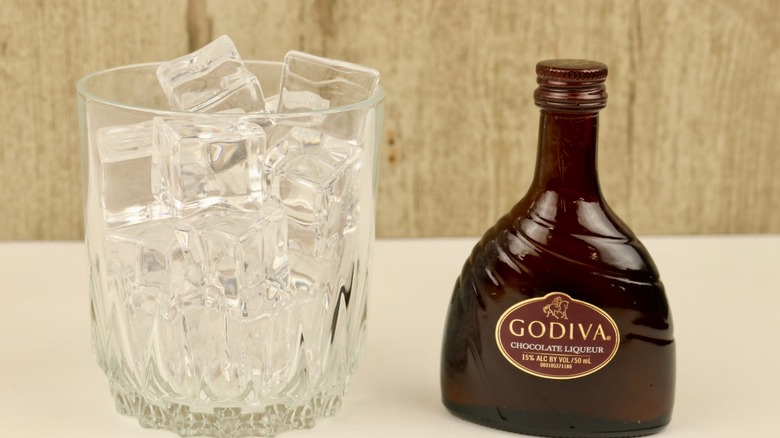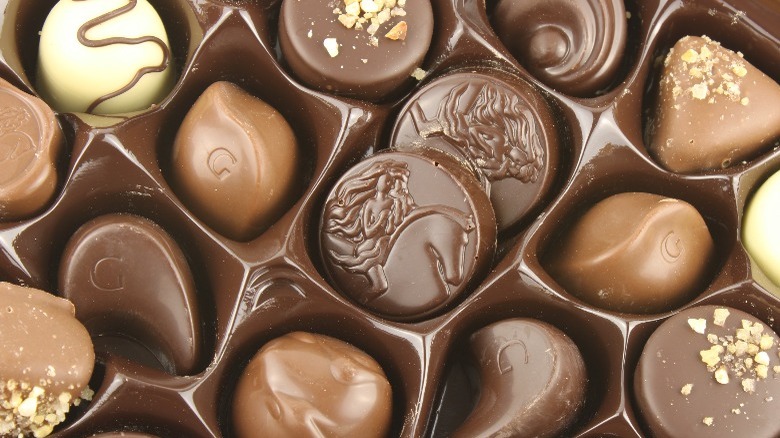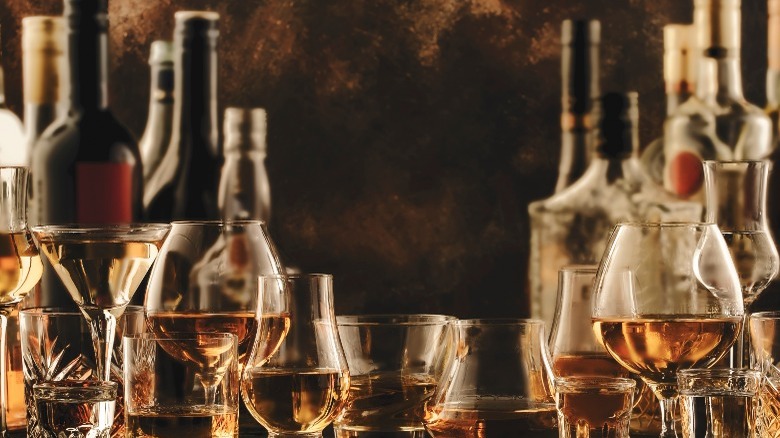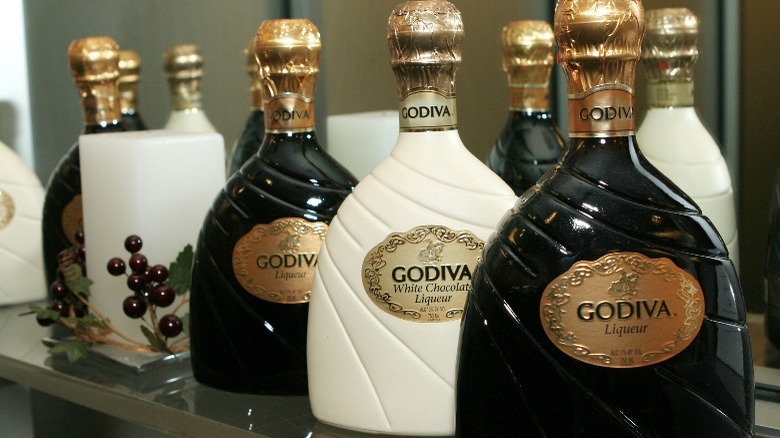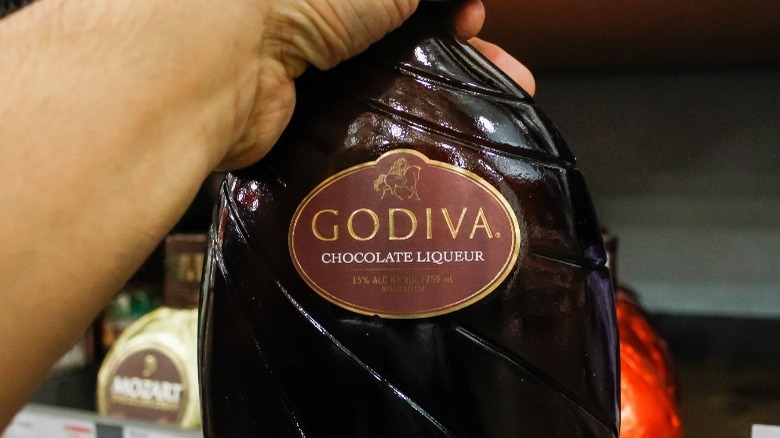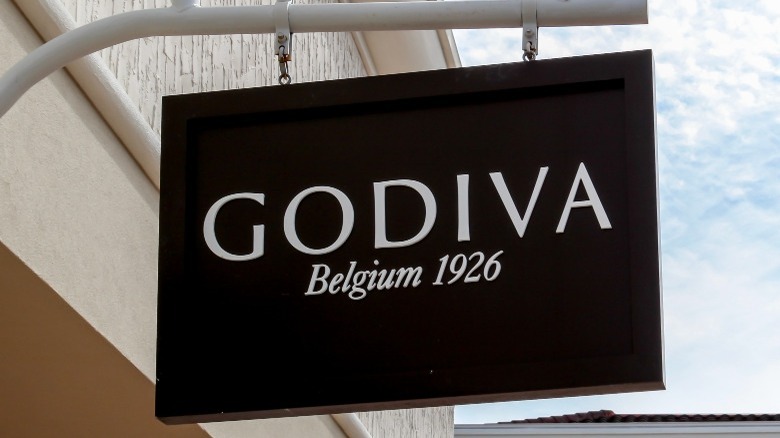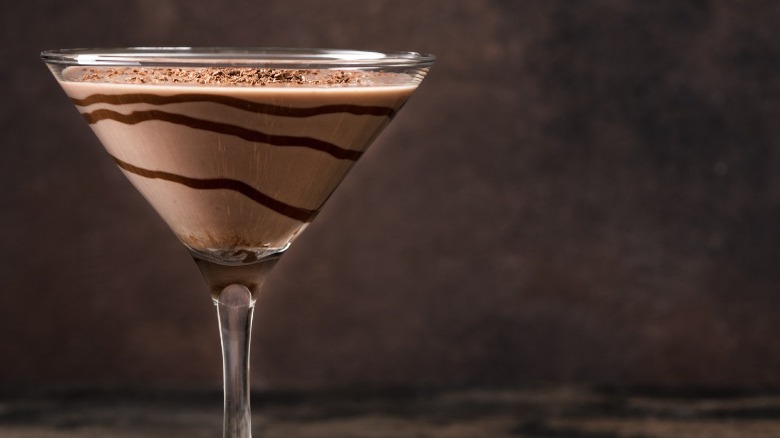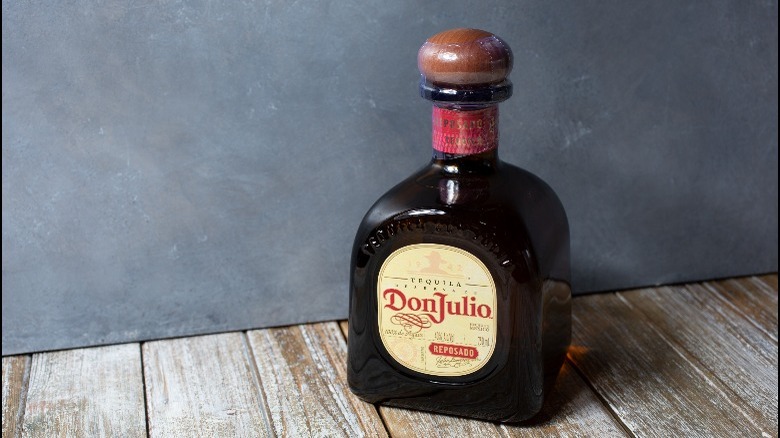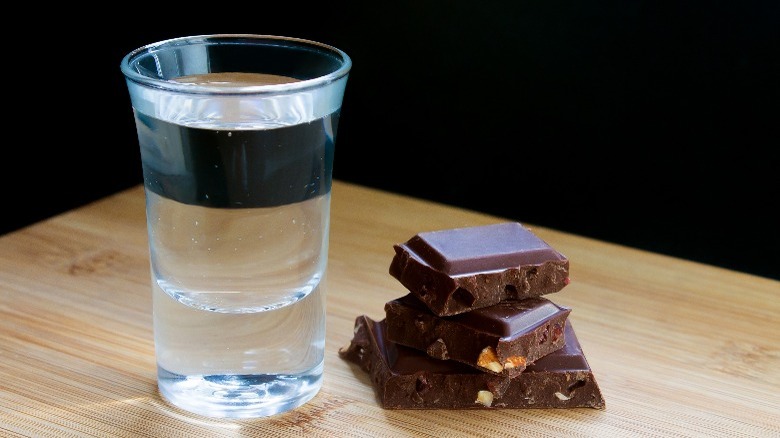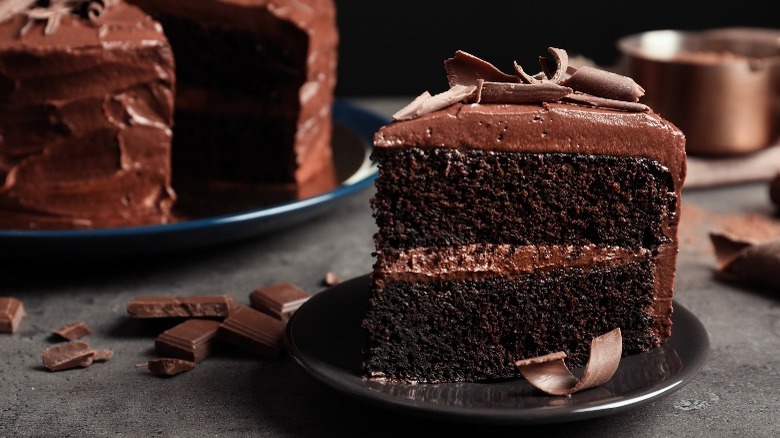The Untold Truth Of Godiva Liqueur
Chocolates and alcohol make great gifts for hosts and romantic partners. When your alcohol comes from a Belgian chocolate company, though, you may not want to share. Godiva Chocolate Liqueurs have been befuddling taste buds for nearly three decades, and the company's origin story reaches much farther back in time.
What's the story? Why is there a naked woman riding a horse on the label? Are the products really that different from each other? What do you do with chocolate liqueur anyway?
It's a drink everyone wants to love, but these creamy liqueurs don't suit everyone. Love it or hate it, Godiva liqueur has untold truths to share. There's a lot of chocolate in store, some tragically abandoned spin-off products, and a touch of ancient history. If you want more, don't worry. There's plenty, including some liqueur-infused cake. You probably shouldn't share it with the kids, though.
It all began with chocolate
The story of Godiva liqueur begins with the untold truth of Godiva chocolate. Pierre Draps began making candy in 1926. At first, he only sold to local shops in Brussels, Belgium, but according to Company Histories, it didn't take long for him to open a shop all his own. The brand grew to open other shops around the country, then around Europe, and eventually around the world.
The boutique chocolates have maintained their allure for nearly 100 years. This is thanks in part to the mystique of their branding, but it owes to their sincere devotion to chocolate, too. The Godiva website has an entire page educating potential buyers on the beans, process, and technique behind their products.
Over the years, Godiva's branding has leaned into storytelling, particularly stories about strong women. One of the brand's earliest signature chocolates, the Comtesse, was inspired by their namesake, Lady Godiva (via Company Histories). One of Godiva's official sites explains how "Gone with the Wind," and the feather in Scarlett's hat, inspired the Autant, a leaf-shaped milk chocolate with coffee and chocolate creams. The brand continues to honor its namesake through programs like the Lady Godiva Initiative, which aims to support women and their communities around the world.
A real woman inspired the name
Godiva plucked its name, logo, and inspiration from an old English story, but there's more fact behind the tale than many realize. According to legend and the History channel, Lady Godiva had a generous heart and a dedicated interest in the betterment of her people. Unfortunately, her husband overlooked the plight of his overtaxed peasants, and laughed when his wife argued for livable rates. He said, jokingly, that he'd happily lower the taxes when she rode through town naked.
She took him at his word. After warning the townsfolk in advance to go inside and close the blinds, Lady Godiva rode her horse through the abandoned city streets with nothing but her long hair to wear. Cowed by his wife's dedication, and caught with his foot in his mouth, the count lowered the taxes.
Lady Godiva isn't based purely on fantasy. According to History, the story of her one-woman parade in her birthday suit is a later invention, but the woman herself, Godgifu, lived in the 11th Century. She and her husband had a reputation for good works. Godiva, or Godgifu, also owned land and had a lot of power, particularly for a woman. A creative monk and one Alfred Tennyson honed the fantastical elements of Lady Godiva's life. So, the woman honored on the liqueur's packaging is a real historical figure with a really unlikely legend to explain her good works.
It's a liqueur, not a liquor, and here's what that means
Godiva Chocolate Liqueur is not a liquor, but what does that mean? Apart from a few letters, what's the difference between a liquor and a liqueur? How much does the distinction matter? A few rules govern the border between these two types of alcoholic products. It's easiest to begin by defining liquor. The Spruce Eats defines liquors as fairly simple distilled spirits and lists brandy, gin, rum, tequila, whiskey, and vodka as the six most commonly recognized.
Mic describes liqueurs as sweetened distilled alcohols made from liquors. But where, you may ask, do flavored liquors fall? Are they automatically liqueurs? Here's where the rules get murky. The Spruce Eats reports that the difference depends on type of liquor and the associated standards. The next time you grab your favorite flavored whiskey or bourbon, look for a sneaky little "liqueur" written after the name of the liquor.
If you're confused, just remember: Whiskey is a liquor and Irish cream is a liqueur. These two drinks have a clear distinction, even though they both contain whiskey. The difference is in the additives and special flavors. Creamy liqueurs are the easiest to distinguish, because you know nothing distills with that kind of texture. Godiva chocolate liqueurs land in this category.
How does this affect your consumption? You should expect a liqueur to be sweeter, but that's it. Drink it straight, in a cocktail, or however you please.
They started with one flavor
Once upon a time, there was one and only one Godiva Chocolate Liqueur. Reference for Business reports the original liqueur launched in 1993 alongside Godiva's new coffee line. According to The Spruce Eats, Godiva's liqueur stood apart from crème de cacao thanks to its creaminess and muted sweetness. The liqueur did so well that eventually the company added a second flavor to its regular lineup: white chocolate. The white chocolate liqueur prioritized its vanilla notes. According to Godiva, it uses real Madagascar vanilla to deliver a smooth drink that isn't at all bland.
Today, Godiva regularly sells three chocolate liqueurs. The original became the milk chocolate variety, but the packaging doesn't always reflect that shift. Be aware that any Godiva liqueur that doesn't say otherwise falls into the milk chocolate category. White chocolate has stayed on the menu as well, and the newest arrival is a dark chocolate twist that takes a new approach to the classic recipe. Each has distinctive flavors to suit a range of tastes and creative cocktails.
Dark chocolate delivers something new
Although the Belgian chocolatiers who craft Godiva's chocolates don't make vats of liqueur by hand, they still play a major part in the creation of new drinks. The newest of the three primary liqueur flavors, dark chocolate, only joined the family in 2014. The Beverage Journal reports that Godiva's Global Executive Chef Chocolatier worked with the actual production company for the product, Diageo, to make it the best it could be.
The description given to retailers implied the goal of the dark chocolate liqueur was to perfectly match Godiva's 72% dark chocolate flavor. This very specific goal isn't the only thing that sets the dark chocolate apart from Godiva's milk and white chocolate liqueurs, though. While still thick, it isn't creamy. In fact, it's the only dairy-free liqueur in the entire collection. If you're worried about indulging in both chocolate and alcohol, you'll be happy to hear that Godiva Dark Chocolate Liqueur has only half the calories of the other two flavors.
They have discontinued flavors we want back
Godiva knows what works, and it's easy to find their chosen three flavors. Unfortunately, they've decided some tasty alternatives don't belong on liquor store shelves next to milk, white, and dark chocolate. It's hard to say what they have against caramel, but you have to go on a long hunt to find Godiva Caramel Liqueur. Despite its name, it's actually a mix of milk chocolate and caramel flavors, just like a candy bar.
As coffee-lovers know, nothing brightens a morning's cup of joe like chocolate. Godiva Mocha Liqueur, however, didn't win a place with the big three, either — you have to hunt for it on websites that help connoisseurs track down fine wines, and the price is creeping toward double the original listing.
Godiva's Cappuccino Liqueur hit retailers, sold out, and never returned. It's another rare beast you'll need luck and a little extra pocket money to bring home. Even shops that keep the listing in hopes of its return mark it out of stock.
Godiva has some suggestions
Godiva understands a chocolate liqueur may be hard to mix for new fans, so they have a bunch of recipes for you to try. There's nothing wrong with pouring some over ice cream or sipping a liqueur over ice, but nothing makes you look like a classy host like a Godiva Grand Martini.
Godiva Liqueur's official website has a special list of recipes for each of their products. If you are brave, you can attempt the Pumpkin Pie-tini. If you want to challenge your taste buds, go for the Spicy Mistletoe Martini. When you're tired of martinis, retreat to the Lunar Love. With over a dozen recipes, the guide can help you find something suited to your tastes. At the very least, these suggestions can help you design your own drink with Godiva liqueurs.
Each drink features an image of the finished cocktail, complete with a suggested garnish. The picture is a good way to help tell if you've made a big mistake as you work through the recipe. If you want a better idea of what a creamy liqueur looks like in a glass, or want to see the difference of the dark chocolate flavor, the pictures can help with that, too.
Godiva and Don Julio have something in common
Diageo produces Godiva Liqueur products (via Fab News). They also control some of the rights of other major liquor and liqueur brands like Ciroc, Don Julio, and Bulleit. If you're interested in the recipes mentioned earlier, you'll probably add some of these to your bar. In a beautiful cross-pollination of major alcohol brands, Diageo introduced the ingredients they knew best to the Godiva recipes. The Chocolate Martini calls for Ciroc. The Lunar Love needs tea-infused Bulleit bourbon. Apparently great products work, and sell, better together.
Diageo also has their own stash of recipes online. They call their collection the Diageo Bar Academy, and it has a much broader scope than the Godiva website's recipe list. However, the lovely lady of chocolate appears here, too. Some recipes are as simple as they sound, like Godiva on the Rocks. If you want to get creative with a summer drink, though, the Godiva Chocolate Freeze offers a slightly more inventive approach to cocktails.
Godiva vodka is the liqueur's secret cousin
If you go hunting for the official word on Godiva Chocolate Vodka, you probably won't find one. Although the flavored vodka appears in recipes and on retailer websites, it appears to have suffered a similar fate as the caramel, mocha, and espresso liqueur flavors. It's almost always listed as out of stock, and it doesn't appear on the official Godiva Liqueur website at all, even though adding chocolate vodka to a chocolate martini sounds like a pretty good idea.
The bottle looks nothing like the short liqueur containers. It's a tall, clear glass with a sideways Godiva logo. And the original Godiva vodka isn't even a stand-alone product. Godiva Chocolate Raspberry Vodka existed, too. It had the same short wine bottle aesthetic as the original, and it sounds like an even more exciting twist for a chocolate martini. It's a very tasty mystery.
Get baking! Godiva liqueur isn't just for drinking
What if you could sip your liqueur and eat it, too? Not all great chocolate liqueur recipes end in cocktails. Those are, of course, delicious, but they aren't the only way to enjoy Godiva liqueurs.
You don't need exceptional skills to make most of the great Godiva liqueur recipes out there (via Yummly), but you can start easy with chocolate liqueur ice pops. They're the DIY solution for grown-up pool party snacks. Feeling ambitious? Try making homemade ice cream with it.
Godiva liqueur isn't just for frozen goodies, though. A bit of liqueur transforms chocolate madeleines, and have you considered the joy of Godiva liqueur cupcakes? Remember, alcohol bakes out, and liqueurs are all about the flavor. It goes without mentioning how a creamy liquor helps chocolate chip cookies. Adding a little can give your baked goods and desserts a huge boost.
You don't have to give up the edge of alcohol, though. Even if you bake out the booze in your cake, you can always add more to the icing.
